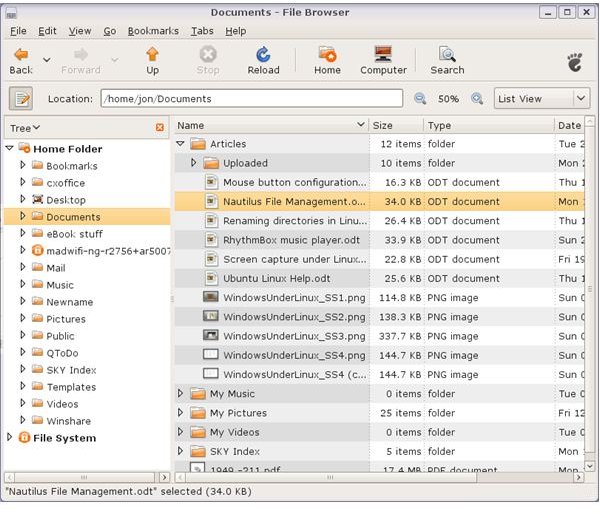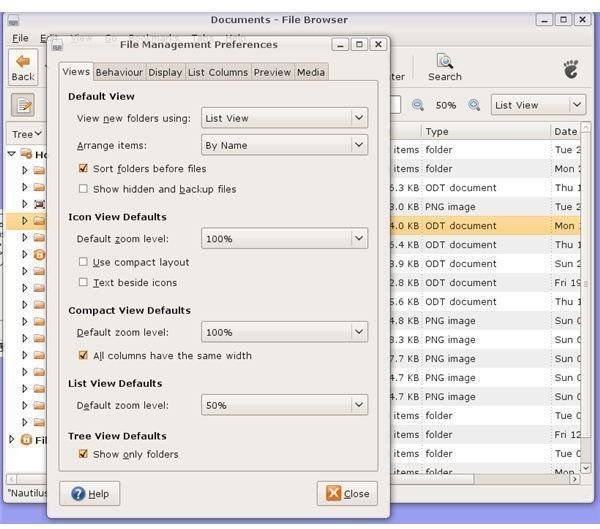Review of Nautilus File Browser for Linux GNOME Distros
Starting and Configuring Nautilus
Nautilus is the default graphic file management program for GNOME-based Linux systems. There are alternative file managers – PCMan, Thunar and GNOME Commander, for instance, as well as the KDE default Konqueror, but for most users Nautilus will meet their requirements well. In some distros Nautilus also doubles as a web browser, but most users prefer Mozilla Firefox, and this is now usually installed by default, and the Nautilus web capabilities are disabled.
To start Nautilus, click one of the ‘location’ entries in the Places menu. e.g. ‘Home Folder’. A Nautilus window will open, divided vertically into two parts. By default the left panel will show a list of folders and drives, and the right section will show the files in the currently selected folder. A new feature in the latest Nautilus is that removable drives like CDs or network shares show an ‘Eject’ icon next to their names in the left panel; clicking on this should eject the CD and/or unmount the associated drive.
To change the display at the left, click on the header at the top of the panel. There are five choices available: Places, Information. Tree, History, Notes and Emblem. Places is the default setting and shows a flat list of folders at the current level; Tree displays these as a hierarchical list like the Folders setting in Windows Explorer. History shows locations you have been to recently, while Information, Notes and Emblem show some of the properties of the selected file or folder.
The Edit / Preferences menu item brings up some useful settings. In particular you can choose whether each new location opens in a new window (‘Browser mode’) or in the same window (‘Spatial mode’). You can also choose a single-click option for opening folders and files.
Navigation
To navigate to a new location, either click on an entry at the left or double-click in one of the folders at the right. A Navigation toolbar at the top of the panel allows users to retrace their steps or to move upwards through the hierarchy towards the root directory. A new location can also be typed in the Address bar – e.g. ‘etc/apt/’ – and pressing Enter will take the user to this location.
Right-clicking on an entry on either side allows the user to open it in a new window – handy when there are files to be moved or copied back and forth. Multiple files and folders can selected by Shift-clicking on each one in turn or by using the mouse pointer to drag out a rectangle containing the items.
Files and folders can be deleted – provided you have permissions to do so – by selecting them and pressing Delete or using the ‘Move to garbage bin’ option in the right-mouse local menu. If the file is a recognised type of document or a program it can be opened or run by double-clicking on it. Also on the local menu are options to Rename a file or directory, Make an archive – i.e. compact the file or the directory into a single smaller file – or Encrypt them, though this requires the user to generate an encryption key and supply a passphrase the first time it is used. It will then generate an encrypted copy of the file with a .pgp extension, which requires the passphrase to decrypt back into its original form. The right-click menu can also be used to send a file or directory via email.

Properties, menus, tabs and modes
The final option on the right-click menu is ‘Properties’ which controls the permissions of the file – who can open, read or copy it – and allows the user to add an ‘emblem’ to the file icon to make it stand out. The default application in which to open files of this type can be set here, and some notes can be attached to the file. Files and folders can be moved by dragging and dropping between Nautilus windows or into other folders, and copied by dragging them with the Control key held down, as in Windows.
Nautilus can be used as a tabbed browser by selecting File / New Tab. A second tab will appear pointing to the same locator, and this can then be changed to a new location. Items can be moved or copied between tabbed locations by dragging (or Control-dragging) them from the body of the panel to another tab, and then down into the body of that tabbed panel. The File menu can also be used to create new folders or files.
The Edit menu includes options for Cut, Copy and Select as well as Duplicate – a short-cut combining Copy and Paste. The View menu allows the user to display hidden files and change the type of display between three options: List, Icons or Compact. In the List view the right panel is broken up into columns showing information about the files and folders. These can be sorted by clicking on each column header, and the user can choose exactly what information to display via the View /Visible Columns menu option.
The Go menu allows the user to change to different locations, and the Bookmark menu allows the current location to be added to a Bookmark list. A Tab menu allows the user to navigate between the tabbed windows. The Help menu brings up a comprehensive hyperlinked help system.
It’s not very glamorous, but Nautilus does what it’s supposed to and does it well. It’s reassuring to find such a solid application at the heart of GNOME Linux.

